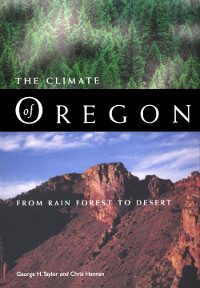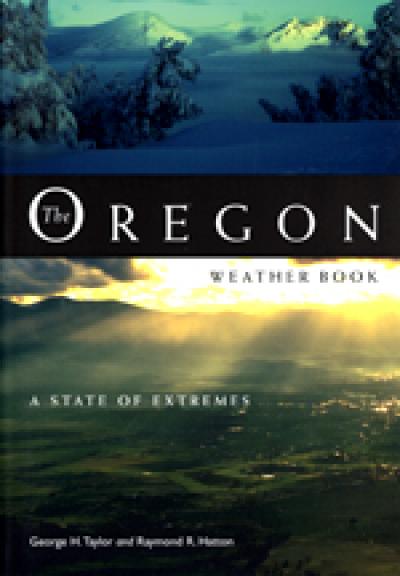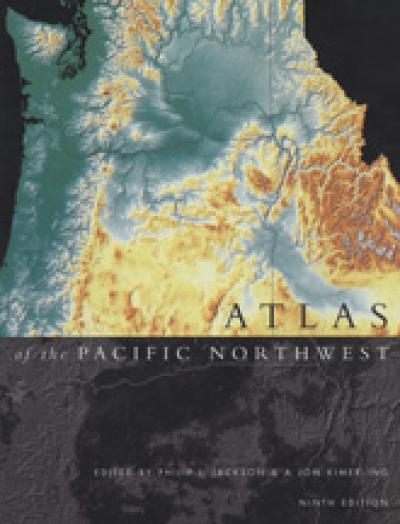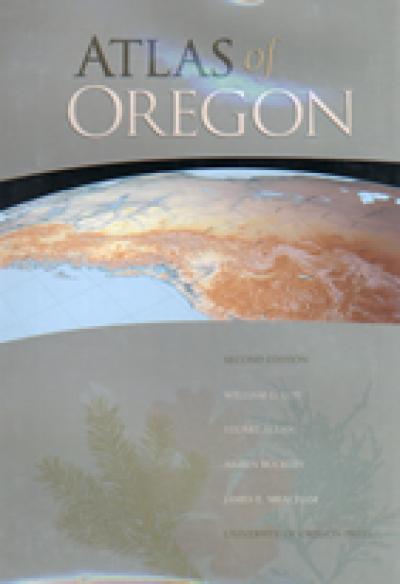
The Climate of Oregon
George H. Taylor and Chris Hannan
Weather is best understood as the state of the atmosphere on a given day or at a given time. Climate, on the other hand, looks at long-term averages of weather conditions. Or, as one 7-year-old explained to State Climatologist George Taylor, "weather is what you get and climate is what you're supposed to get."
The Climate of Oregon gathers into a single volume a range of fascinating and useful climate information. Using state-of-the-art two-color maps and detailed tables, the authors describe various climate elements, including precipitation, temperature, winds, humidity, snow, clouds, and the growing season. Monthly maps for precipitation, snow, and temperature reveal how Oregon's climate changes throughout the year. The book defines the 9 distinct Oregon Climate Zones, examines the role of climate stations in reporting weather, and provides rich data from the state's most representative stations.
Several years of unusual weather in the Pacific Northwest have generated great interest in large-scale climate change. Chapters on global warming and its impact on Oregon, El Niño and La Niña, climate changes and salmon populations, and long-term wet and dry cycles offer the latest findings on these topics.
Also available: The Oregon Weather Book: A State of Extremes, the companion volume to The Climate of Oregon.
About the author
George H. Taylor is the State Climatologist for Oregon. A faculty member of Oregon State University's College of Oceanic and Atmospheric Science, he is Director of the Oregon Climate Service, the state's official repository for weather and climate information. He lives in Corvallis.
Read more about this author
Chris Hannan is a Research Assistant and Manager of Data Services at Oregon Climate Service. She lives in Wilsonville.
Read more about this author
Introduction
Part 1: Large-scale Influences on Oregon's Weather and Climate
Part 2: Climate Elements
- Precipitation
- Temperature
- Winds
- Humidity
- Cloud Cover and Solar Radiation
- Snow
Part 3: Oregon Climate Zones
- Zone 1: The Coastal Area
- Zone 2: The Willamette Valley
- Zone 3: The Southwest Interior
- Zone 4: The Northern Cascades
- Zone 5: The High Plateau
- Zone 6: The North Central Area
- Zone 7: The South Central Area
- Zone 8: The Northeast Area
- Zone 9: The Southeast Area
Part 4: Measuring and Reporting Climate Information
- Who Does It?
- Types of Observations
- Access to Data via the Internet
- Data for Selected Oregon Stations
Part 5: Time Series
- Water Year Precipitation for Oregon Climate Zones
- Water Year Precipitation for Selected Oregon Stations
Part 6: Special Topics
- Long-term Wet-Dry Cycles in Oregon
- Long-term Climate Trends and Salmon Populations
- The El-Nino-Southern Oscillation Phenomenon
- Global Climate Change
Part 7: Appendices
- Climate "Normals"
- Glossary
Index
Weather in Oregon varies a lot across the state, from generally cloudy and wet near the coast to wet, snowy, and cold in the mountains, and mostly sunny and dry east of the Cascades. Then again, weather varies from season to season, with Oregon having generally cool, wet winters and warm, dry summers. But weather also changes from day to day, and sometimes from hour to hour.
Put all these variations together, average them over 30 years or so, and you get climate, the long-term average of weather conditions. That's what this book is all about. Not clouds and rain and heat waver and ice storms — those are in the companion book, The Oregon Weather Book — but rather numbers, statistics, graphs, and maps. Dry, maybe (no pun intended), but that's climate for you: much less exciting than weather.
Less exciting, but very useful. Every week Oregon Climate Service's website gets over 40,000 "hits" (data requests). Farmers, scientists, engineers, students, attorneys — plus all those folks who just love weather and climate, and whose favorite TV station is the Weather Channel — log on, look around, grab data and images, and go away satisfied (we hope!). And more often than not, it's climate information they need, for making climate-oriented decisions: what to plant, when to plant it, where to build, how big to make it, when to vacation, where to vacation, and so on, and so on. The fact is, climate affects lots of people in lots of ways.
Oregon Weather Records
| Highest temperature: | 119 F | Pendleton | July 29, 1898 |
|---|---|---|---|
| Lowest temperature: | -54 F | Ukiah Seneca |
Feb 9, 1933 Feb 10, 1933 |
| Wettest day: | 11.65 inches | Port Orford 5E* | Nov 19, 1996 |
| Wettest month: | 52.78 inches | Glenora | Dec 1917 |
| Wettest year: | 204.12 inches | Laurel Mountain | 1996 |
| Driest year: | 3.33 inches | Warm Springs Reservoir | 1939 |
| Greatest 1-day snowfall: | 39 inches | Bonneville Dam | Jan 1980 |
| Greatest 1-month snowfall: | 313 inches | Crater Lake | Jan 1950 |
| Greatest annual snowfall: | 903 inches | Crater Lake | 1950 |
| Highest wind speed: | 131 mph | Mt. Hebo | Oct 12, 1962 |
| Lowest pressure: | 28.51 inches | Astoria | Dec 12, 1995 |
* Port Orford 5E is the station 5 miles east of Port Orford.
"A great reference one-stop shopping for Oregon's weather and climate information."




